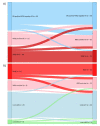Breast cancer subtypes: implications for the treatment and survival of patients in Africa-a prospective cohort study from Mozambique
- PMID: 33020218
- PMCID: PMC7537337
- DOI: 10.1136/esmoopen-2020-000829
Breast cancer subtypes: implications for the treatment and survival of patients in Africa-a prospective cohort study from Mozambique
Abstract
Background: Data regarding breast cancer epidemiology, treatment and survival in Africa are scarce. We aimed to assess the distribution of breast cancer subtypes in Mozambique and its impact on patients' treatment and survival. The concordance of biomarker assessment between cytological and histological samples was also evaluated.
Methods: Prospective cohort study including 210 patients diagnosed between January 2015 and August 2017, followed to November 2019. Clinicopathological characteristics, treatment, 3-year overall survival (OS) and disease-free survival (DFS) were compared across classic tumour subtypes (oestrogen receptor (ER)-positive/human epidermal growth factor receptor 2 (HER2)-negative, HER2-positive and triple-negative breast cancer (TNBC)) and surrogate intrinsic subtypes (St. Gallen classification). Concordance was measured using Cohen's κ statistics.
Results: A total of 51% of patients had ER-positive/HER2-negative tumours, 24% HER2-positive and 25% TNBC. Concordance between cytological and histological samples regarding ER and HER2 status was substantial (κ=0.762 and κ=0.603, respectively). There were no significant differences across subtypes regarding clinical characteristics and treatment, except for HIV positivity and high histological grade (more prevalent among TNBC) or endocrine therapy (higher use among ER-positive/HER2-negative and HER2-positive patients). Three-year OS was 52.5% (95% CI, 44.3% to 60.0%), being higher in ER-positive/HER2-negative (61.1%) compared with HER2-positive (53.2%) and TNBC (31.9%) patients. Adjusted HRs were 1.96 (95% CI, 1.13 to 3.39) among HER2-positive and 3.10 (95% CI, 1.81 to 5.31) among TNBC versus ER-positive/HER2-negative patients. Three-year DFS was 46.6% (95% CI, 38.0% to 54.8%), being lower among TNBC versus ER-positive/HER2-negative patients (HR 2.91; 95% CI, 1.64 to 5.16). Results were similar between surrogate intrinsic subtypes.
Conclusion: There was a high proportion of HER2-positive and TNBC among Mozambican patients and their survival was poor compared with ER-positive/HER2-negative patients, partly due to the limited treatment options. A systematic assessment of ER, PR and HER2 status is feasible and may help tailoring and optimise the treatment of patients with breast cancer in low-resource settings, potentially leading to survival gains in this underserved population.
Keywords: biomarkers; breast neoplasms; global health; sub-Saharan Africa; survival analysis.
© Author (s) (or their employer(s)) 2020. Re-use permitted under CC BY-NC. No commercial re-use. Published by BMJ on behalf of the European Society for Medical Oncology.
Conflict of interest statement
Competing interests: MB: travel grant and speaker honoraria from Roche/GNE; research grants for her institute from Radius, AstraZeneca, Lilly, MSD, GSK/Novartis, Roche/GNE, Synthon, Servier and Pfizer.
Figures


Similar articles
-
Distribution of molecular breast cancer subtypes among Algerian women and correlation with clinical and tumor characteristics: a population-based study.Breast Dis. 2015;35(2):95-102. doi: 10.3233/BD-150398. Breast Dis. 2015. PMID: 25736840
-
Therapy response and prognosis of patients with early breast cancer with low positivity for hormone receptors - An analysis of 2765 patients from neoadjuvant clinical trials.Eur J Cancer. 2021 May;148:159-170. doi: 10.1016/j.ejca.2021.02.020. Epub 2021 Mar 18. Eur J Cancer. 2021. PMID: 33743484
-
Expression of SIRT1, SIRT3 and SIRT6 Genes for Predicting Survival in Triple-Negative and Hormone Receptor-Positive Subtypes of Breast Cancer.Pathol Oncol Res. 2020 Oct;26(4):2723-2731. doi: 10.1007/s12253-020-00873-5. Epub 2020 Jul 17. Pathol Oncol Res. 2020. PMID: 32681437
-
Triple-negative breast cancer prevalence in Africa: a systematic review and meta-analysis.BMJ Open. 2022 May 27;12(5):e055735. doi: 10.1136/bmjopen-2021-055735. BMJ Open. 2022. PMID: 35623750 Free PMC article.
-
Receptor-Defined Breast Cancer in Five East African Countries and Its Implications for Treatment: Systematic Review and Meta-Analysis.JCO Glob Oncol. 2021 Feb;7:289-301. doi: 10.1200/GO.20.00398. JCO Glob Oncol. 2021. PMID: 33591798 Free PMC article.
Cited by
-
Immunohistochemistry versus PCR Technology for Molecular Subtyping of Breast Cancer: Multicentered Expereinces from Addis Ababa, Ethiopia.J Cancer Prev. 2023 Jun 30;28(2):64-74. doi: 10.15430/JCP.2023.28.2.64. J Cancer Prev. 2023. PMID: 37434799 Free PMC article.
-
Regional Variation in the Tumor Microenvironment, Immune Escape and Prognostic Factors in Breast Cancer in Sub-Saharan Africa.Cancer Immunol Res. 2023 Jun 2;11(6):720-731. doi: 10.1158/2326-6066.CIR-22-0795. Cancer Immunol Res. 2023. PMID: 37058582 Free PMC article.
-
Navigating the Nexus: HIV and Breast Cancer-A Critical Review.Int J Mol Sci. 2024 Mar 12;25(6):3222. doi: 10.3390/ijms25063222. Int J Mol Sci. 2024. PMID: 38542195 Free PMC article. Review.
-
Oncology in Mozambique: Overview of the Diagnostic, Treatment, and Research Capacity.Cancers (Basel). 2023 Feb 11;15(4):1163. doi: 10.3390/cancers15041163. Cancers (Basel). 2023. PMID: 36831505 Free PMC article. Review.
-
Highlights from the 4th PALOP-AORTIC Conference on Cancer, 29-31 July 2020, Luanda, Angola.Ecancermedicalscience. 2020 Sep 21;14:1108. doi: 10.3332/ecancer.2020.1108. eCollection 2020. Ecancermedicalscience. 2020. PMID: 33144876 Free PMC article.
References
Publication types
MeSH terms
Substances
LinkOut - more resources
Full Text Sources
Research Materials
Miscellaneous

